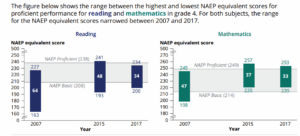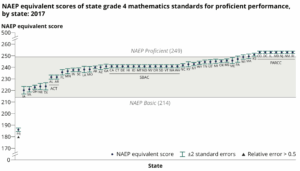By Dale Chu
Some honest-to-goodness good news today: The latest National Center for Education Statistics (NCES) study shows that states have raised the cut scores for proficiency on state tests. Both Education Week and U.S. News and World Report have strong write-ups on the study. What this news means is that the honesty gap—the discrepancy between how proficiency is defined on the National Assessment of Education Progress (NAEP) and a state’s definition—continues to close. In addition, the gap between states with the highest performance standard and the lowest performance standard are narrowing as well. Consider the figures below:
Fourth grade reading and math

Eight grade reading and math

Back in 2007, the Thomas B. Fordham Institute issued a report titled “The Proficiency Illusion” in an effort to call out the false impression of success often provided by state tests. There are a number of troubling issues that arise when students fail to meet academic standards, but are told they are proficient nonetheless. The sunlight provided by the NCES study has encouraged states to be more honest about how they report student performance. As Peggy Carr, associate commissioner of assessments at NCES notes:
When we started this study back in the early 2000s, states weren’t really happy about this study because it was revealing that they all had different conceptual frameworks about what was proficient. I think now that we are revealing what everybody is doing via a common metric they are second-guessing where they are deciding to draw their cut points. So what you’re seeing for the most part is the bottom is coming up.
The complete report is worth reviewing in its entirety. I found the state-by-state comparisons particularly interesting. For example, here is fourth grade math:

I was disappointed to see Indiana, my former home, toward the back of the pack considering that the state was once a member of the PARCC consortium. Notably, the PARCC standard for fourth grade math mapped to the NAEP proficient level, a boon to Colorado, D.C., Illinois, Maryland, New Jersey, New Mexico, and Rhode Island.
The sticky wicket in all of this good news is that with the exception of D.C, the remaining PARCC states have indicated that they may switch or alter their assessments. This raises the question of whether the positive trend we’re celebrating today will continue. With states continuing to play musical chairs with their tests, only time will tell.
